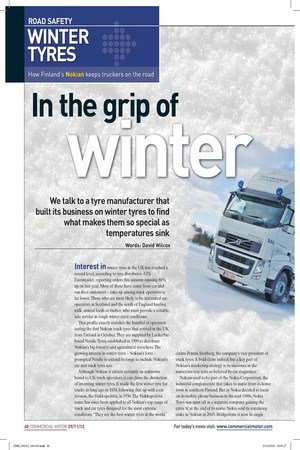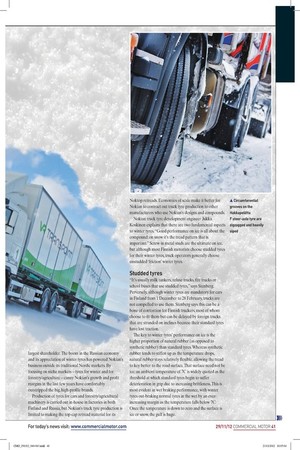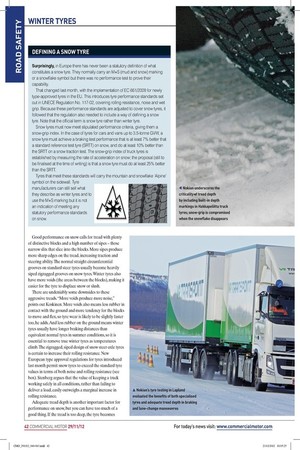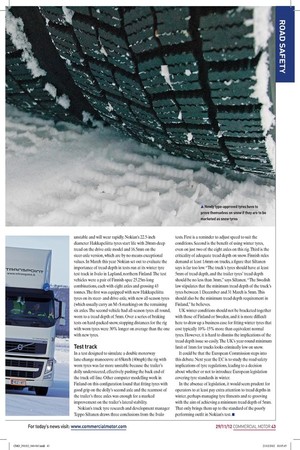In the grip of
Page 34

Page 35

Page 36

Page 37

If you've noticed an error in this article please click here to report it so we can fix it.
We talk to a tyre manufacturer that built its business on winter tyres to find what makes them so special as temperatures sink
Words: David Wilcox Interest in winter tyres in the UK has reached a record level, according to tyre distributor ATS Euromaster, reporting orders this autumn running 80% up on last year. Most of those have come from car and van fleet customers – take-up among truck operators is far lower. Those who are most likely to be interested are operators in Scotland and the north of England hauling milk, animal feeds or timber, who must provide a reliable, safe service in tough winter rural conditions.
That profile exactly matches the handful of operators testing the first Nokian truck tyres that arrived in the UK from Finland in October. They are supplied by Lockerbiebased Nordic Tyres, established in 1999 to distribute Nokian’s big forestry and agricultural tyres here. The growing interest in winter tyres – Nokian’s forte – prompted Nordic to extend its range to include Nokian’s car and truck tyres too.
Although Nokian is almost certainly an unknown brand to UK truck operators, it can claim the distinction of inventing winter tyres. It made the first winter tyre for trucks as long ago as 1934, following that up with a car version, the Hakkapeliitta, in 1936. The Hakkapeliitta name has since been applied to all Nokian’s top range of truck and car tyres designed for the most extreme conditions. “They are the best winter tyres in the world,” claims Pontus Stenberg, the company’s vice-president of truck tyres. A bold claim indeed, but a key part of Nokian’s marketing strategy is its successes in the numerous tyre tests so beloved by car magazines.
Nokian used to be part of the Nokia Corporation, the industrial conglomerate that takes its name from its home town in southern Finland. But as Nokia decided to focus on its mobile phone business in the mid-1990s, Nokia Tyres was spun off as a separate company, gaining the extra ‘n’ at the end of its name. Nokia sold its remaining stake in Nokian in 2003: Bridgestone is now its single largest shareholder. The boom in the Russian economy and its appreciation of winter tyres has powered Nokian’s business outside its traditional Nordic markets. By focusing on niche markets – tyres for winter and for forestry/agriculture – canny Nokian’s growth and profit margins in the last few years have comfortably outstripped the big, high-profile brands.
Production of tyres for cars and forestry/agricultural machinery is carried out in-house in factories in both Finland and Russia, but Nokian’s truck tyre production is limited to making the top-cap retread material for its Noktop retreads. Economies of scale make it better for Nokian to contract out truck tyre production to other manufacturers who use Nokian’s designs and compounds.
Nokian truck tyre development engineer Jukka Koskinen explains that there are two fundamental aspects to winter tyres. “Good performance on ice is all about the compound; on snow it’s the tread pattern that is important.” Screw-in metal studs are the ultimate on ice, but although most Finnish motorists choose studded tyres for their winter tyres, truck operators generally choose unstudded ‘friction’ winter tyres.
Studded tyres
“It’s usually milk tankers, refuse trucks, fire trucks or school buses that use studded tyres,” says Stenberg. Perversely, although winter tyres are mandatory for cars in Finland from 1 December to 28 February, trucks are not compelled to use them. Stenberg says this can be a bone of contention for Finnish truckers, most of whom choose to fit them but can be delayed by foreign trucks that are stranded on inclines because their standard tyres have lost traction.
The key to winter tyres’ performance on ice is the higher proportion of natural rubber (as opposed to synthetic rubber) than standard tyres. Whereas synthetic rubber tends to stiffen up as the temperature drops, natural rubber stays relatively flexible, allowing the tread to key better to the road surface. That surface need not be ice: an ambient temperature of 7C is widely quoted as the threshold at which standard tyres begin to suffer deterioration in grip due to increasing brittleness. This is most evident in wet braking performance, with winter tyres out-braking normal tyres in the wet by an everincreasing margin as the temperature falls below 7C. Once the temperature is down to zero and the surface is ice or snow, the gulf is huge. Good performance on snow calls for tread with plenty of distinctive blocks and a high number of sipes – those narrow slits that slice into the blocks. More sipes produce more sharp edges on the tread, increasing traction and steering ability. The normal straight circumferential grooves on standard steer tyres usually become heavily siped zigzagged grooves on snow tyres. Winter tyres also have more voids (the areas between the blocks), making it easier for the tyre to displace snow or slush.
There are undeniably some downsides to these aggressive treads. “More voids produce more noise,” points out Koskinen. More voids also means less rubber in contact with the ground and more tendency for the blocks to move and flex, so tyre wear is likely to be slightly faster too, he adds. And less rubber on the ground means winter tyres usually have longer braking distances than equivalent normal tyres in summer conditions, so it is essential to remove true winter tyres as temperatures climb. The zigzagged, siped design of snow steer-axle tyres is certain to increase their rolling resistance. New European type approval regulations for tyres introduced last month permit snow tyres to exceed the standard tyre values in terms of both noise and rolling resistance (see box). Stenberg argues that the value of keeping a truck working safely in all conditions, rather than failing to deliver a load, easily outweighs a marginal increase in rolling resistance.
Adequate tread depth is another important factor for performance on snow, but you can have too much of a good thing. If the tread is too deep, the tyre becomes unstable and will wear rapidly. Nokian’s 22.5-inch diameter Hakkapeliitta tyres start life with 20mm-deep tread on the drive-axle model and 16.5mm on the steer-axle version, which are by no means exceptional values. In March this year Nokian set out to evaluate the importance of tread depth in tests run at its winter tyre test track in Ivalo in Lapland, northern Finland. The test vehicles were a pair of Finnish-spec 25.25m-long combinations, each with eight axles and grossing 43 tonnes. The first was equipped with new Hakkapeliitta tyres on its steerand drive-axle, with new all-season tyres (which usually carry an M+S marking) on the remaining six axles. The second vehicle had all-season tyres all round, worn to a tread depth of 5mm. Over a series of braking tests on hard-packed snow, stopping distances for the rig with worn tyres were 30% longer on average than the one with new tyres.
Test track
In a test designed to simulate a double motorway lane-change manoeuvre at 65km/h (40mph) the rig with worn tyres was far more unstable because the trailer’s dolly understeered, effectively pushing the back end of the truck off-line. Other computer modelling work in Finland on this configuration found that fitting tyres with good grip on the dolly’s second axle and the rearmost of the trailer’s three axles was enough for a marked improvement on the trailer’s lateral stability.
Nokian’s truck tyre research and development manager Teppo Siltanen draws three conclusions from the Ivalo tests. First is a reminder to adjust speed to suit the conditions. Second is the benefit of using winter tyres, even on just two of the eight axles on this rig. Third is the criticality of adequate tread depth on snow. Finnish rules demand at least 1.6mm on trucks, a figure that Siltanen says is far too low. “The truck’s tyres should have at least 5mm of tread depth, and the trailer tyres’ tread depth should be no less than 3mm,” says Siltanen. “The Swedish law stipulates that the minimum tread depth of the truck’s tyres between 1 December and 31 March is 5mm. This should also be the minimum tread depth requirement in Finland,” he believes.
UK winter conditions should not be bracketed together with those of Finland or Sweden, and it is more difficult here to draw up a business case for fitting winter tyres that cost typically 10%-15% more than equivalent normal tyres. However, it is hard to dismiss the implications of the tread depth issue so easily. The UK’s year-round minimum limit of 1mm for trucks looks criminally low on snow.
It could be that the European Commission steps into this debate. Next year the EC is to study the road safety implications of tyre regulations, leading to a decision about whether or not to introduce European legislation covering tyre standards in winter.
In the absence of legislation, it would seem prudent for operators to at least pay extra attention to tread depths in winter, perhaps managing tyre fitments and re-grooving with the aim of achieving a minimum tread depth of 5mm. That only brings them up to the standard of the poorly performing outfit in Nokian’s test. n
DEFINING A SNOW TYRE
Surprisingly, in Europe there has never been a statutory definition of what constitutes a snow tyre. They normally carry an M+S (mud and snow) marking or a snowflake symbol but there was no performance test to prove their capability.
That changed last month, with the implementation of EC 661/2009 for newly type-approved tyres in the EU. This introduces tyre performance standards set out in UNECE Regulation No. 117-02, covering rolling resistance, noise and wet grip. Because these performance standards are adjusted to cover snow tyres, it followed that the regulation also needed to include a way of defining a snow tyre. Note that the official term is snow tyre rather than winter tyre.
Snow tyres must now meet stipulated performance criteria, giving them a snow-grip index. In the case of tyres for cars and vans up to 3.5-tonne GVW, a snow tyre must achieve a braking test performance that is at least 7% better that a standard reference test tyre (SRTT) on snow, and do at least 10% better than the SRTT on a snow traction test. The snow-grip index of truck tyres is established by measuring the rate of acceleration on snow; the proposal (still to be finalised at the time of writing) is that a snow tyre must do at least 25% better than the SRTT.
Tyres that meet these standards will carry the mountain and snowflake ‘Alpine’ symbol on the sidewall. Tyre manufacturers can still sell what they describe as winter tyres and to use the M+S marking but it is not an indication of meeting any statutory performance standards on snow.













































